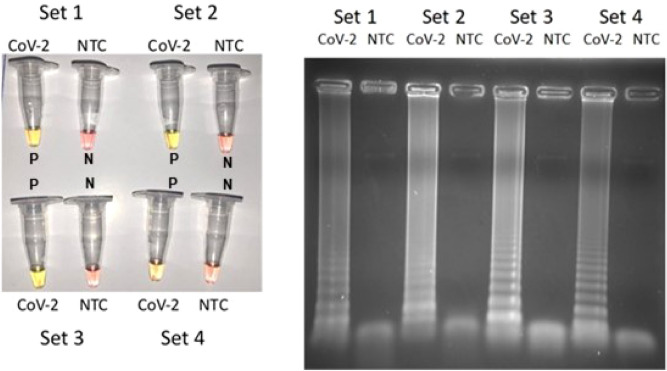Colorimetric RT-LAMP SARS-CoV-2 diagnostic sensitivity relies on color interpretation and viral load
The use of RT-LAMP (reverse transcriptase-loop mediated isothermal amplification) has been considered as a promising point-of-care method to diagnose COVID-19. In this manuscript we show that the RT-LAMP reaction has a sensitivity of only 200 RNA virus copies, with a color change from pink to yellow occurring in 100% of the 62 clinical samples tested positive by RT-qPCR. We also demonstrated that this reaction is 100% specific for SARS-CoV-2 after testing 57 clinical samples infected with dozens of different respiratory viruses and 74 individuals without any viral infection. Although the majority of manuscripts recently published using this technique describe only the presence of two-color states (pink = negative and yellow = positive), we verified by naked-eye and absorbance measurements that there is an evident third color cluster (orange), in general related to positive samples with low viral loads, but which cannot be defined as positive or negative by the naked eye. Orange colors should be repeated or tested by RT-qPCR to avoid a false diagnostic. RT-LAMP is therefore very reliable for samples with a RT-qPCR Ct < 30 being as sensitive and specific as a RT-qPCR test. All reactions were performed in 30 min at 65 °C. The use of reaction time longer than 30 min is also not recommended since nonspecific amplifications may cause false positives.
Authors
Mateus Nóbrega Aoki; Bruna de Oliveira Coelho; Luiz Gustavo Bentim Góes; Paola Minoprio; Edison Luiz Durigon; Luis Gustavo Morello; Fabricio Klerynton Marchini; Irina Natassja Riediger; Maria do Carmo Debur; Helder I Nakaya; Lucas Blanes
External link
Publication Year
Publication Journal
Associeted Project
Microbiology or Immunology
Lista de serviços
-
StructRNAfinder: an automated pipeline and web server for RNA families prediction.StructRNAfinder: an automated pipeline and web server for RNA families prediction.
-
CEMiTool: a Bioconductor package for performing comprehensive modular co-expression analyses.CEMiTool: a Bioconductor package for performing comprehensive modular co-expression analyses.
-
webCEMiTool: Co-expression Modular Analysis Made Easy.webCEMiTool: Co-expression Modular Analysis Made Easy.
-
Assessing the Impact of Sample Heterogeneity on Transcriptome Analysis of Human Diseases Using MDP Webtool.Assessing the Impact of Sample Heterogeneity on Transcriptome Analysis of Human Diseases Using MDP Webtool.
-
Predicting RNA Families in Nucleotide Sequences Using StructRNAfinder.Predicting RNA Families in Nucleotide Sequences Using StructRNAfinder.
-
OUTBREAK: a user-friendly georeferencing online tool for disease surveillance.OUTBREAK: a user-friendly georeferencing online tool for disease surveillance.
-
Noninvasive prenatal paternity determination using microhaplotypes: a pilot study.Noninvasive prenatal paternity determination using microhaplotypes: a pilot study.
-
Editorial: User-Friendly Tools Applied to Genetics or Systems Biology.Editorial: User-Friendly Tools Applied to Genetics or Systems Biology.
-
Automatic detection of the parasite Trypanosoma cruzi in blood smears using a machine learning approach applied to mobile phone imagesAutomatic detection of the parasite Trypanosoma cruzi in blood smears using a machine learning approach applied to mobile phone images
-
Tucuxi-BLAST: Enabling fast and accurate record linkage of large-scale health-related administrative databases through a DNA-encoded approachTucuxi-BLAST: Enabling fast and accurate record linkage of large-scale health-related administrative databases through a DNA-encoded approach
-
Ten quick tips for harnessing the power of ChatGPT in computational biologyTen quick tips for harnessing the power of ChatGPT in computational biology

